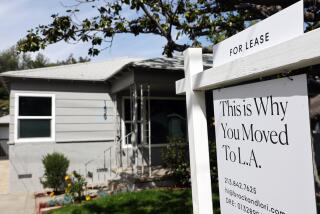Making a Difference : One Facility’s Approach: A Homey Setting for Alzheimers’ Patients
- Share via
At least 150,000 adults in Los Angeles county suffer from Alzheimer’s disease and thousands more from one of some 70 other forms of adult dementia. From the onset of symptoms, the lifespan of those afflicted ranges from three to 20 or more years. Most live with their families where they may need an unmanageable level of social support or in skilled nursing homes where they may have access to more medical care than they need. A group home in Venice provides an alternative with the comforts of home and a high resident-to-staff ratio.
MILESTONES
1981: Linda Laisure’s elderly neighbor, Dorothy Eigen, battling memory loss, wanders away from her Venice home and is lost for two days. A court-appointed social worker asks Laisure, then a case manager with Cedars-Sinai Hospital’s Volunteer Services for Older Persons, to become Eigen’s conservator.
1982-86: The court appoints Laisure conservator and rules that Eigen must be placed in a locked full-care nursing facility for her own safety. Laisure thinks this is inappropriate for someone like Eigen who, despite memory impairment, is ambulatory, active and needs no regular skilled nursing care. She researches and begins fund-raising for a home for elderly care.
1987: Using cast-off furniture and $15,000 of her own money and donations from St. Matthew’s Episcopal Church and friends, Laisure renovates a four-bedroom house in Venice. She receives a California residential care facility license and launches Helping Our Mobile Elderly (H.O.M.E.), a nonprofit board and care facility. After five years in a locked facility, Eigen becomes of H.O.M.E.’s first residents.
1989: H.O.M.E. buys its own home. Board member and realtor Jody Fine works with property owner Stella Crabtree to put together a loan package from California Federal so that H.O.M.E. can purchase its rented facility.
1993: Eigen, now 96 years old, lives in the house with five other women, a live-in caregiver and Purvis, the house cat. Since H.O.M.E.’s opening and with Laisure’s consultation, five similar, unaffiliated residences have opened on the Westside, in Canoga Park and in Sherman Oaks.
BOTTOM LINE
Annual cost Family care (excluding caretakers’ lost wages): $18,000+ H.O.M.E.-style care: $24,000-$27,600 Skilled care nursing home: $24,000-$36,000
Staff to resident ratio H.O.M.E.-style care: 1:3 Skilled care nursing home: 1:7
Source: Alzheimer’s Assn., H.O.M.E., Casa Fe, Casa Aurora
THREE CRITICAL COMPONENTS
Staff Commitment and Family Involvement “Working with people with dementia is such a hard job. You have to have a staff that’s very patient and have a support system (for them) to know that we’re all in this together and that we have to problem solve together.”
“We ask family members to visit at least once a week. Nothing can satisfy a resident like a family member coming in.”
Freedom “Our philosophy is to give the women as much control over their lives as possible, doing everyday tasks like setting the table, folding the laundry, baking cookies. All of this promotes self-worth and self-esteem. . . . They go out for walks two times a day, we have music and dance and a garden.”
Comfort and Safety “If you have enough staffing you have people interacting with the residents all the time. . . . with older adults who have memory loss, familiar things like dressing, gardening, bathing can become complicated if they’re not assisted by a caregiver. These things can be overwhelming. That’s why we have so many staff people.
NEXT STEP
“One of the issues is that the U.S. government will reimburse a person on Medi-Cal or Medicaid $70 a day only for nursing homes. They will not reimburse a residential care facility for the elderly. It makes a lot of sense to reimburse a small place like this if they’re doing a good job, (but) they have to be properly regulated.”
HOW HOME WORKS
“People with (beginning and middle stages of) dementia, Alzheimer’s disease and related disorders function at a higher level if they can live in a simplified, home-like environment--a place that looks like a home, feels like a home because it is a home.”
-- Linda Laisure, founder of HOME
WHY IT WORKS
Dr. Deborah Cherry, program director, Alzheimer’s Assn. of Los Angeles:
Small group homes that can recreate the person’s home are supportive for people with this kind of illness. It’s easier for them to adjust to because it’s a familiar kind of environment, whereas a larger institutional setting is unfamiliar. (With H.O.M.E.) they’re making an adjustment to a new place, but they’re not making an adjustment to a whole new concept of a place to live. They’re going into a (nursing) home.
People with dementia, at least in the beginning and middle stages, usually need a social support. They need attention and care and activities and good nutrition, but they don’t need medical support that much. Nursing home care is a medical model. It costs more and sometimes it’s overkill.






